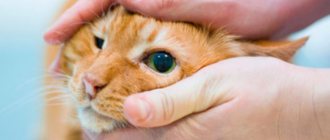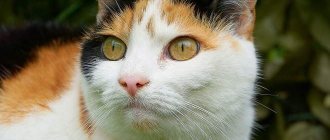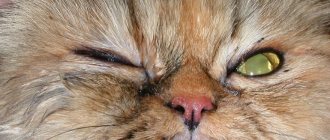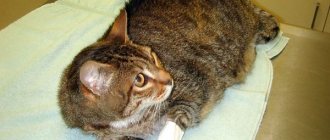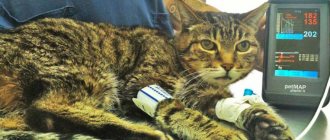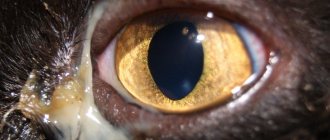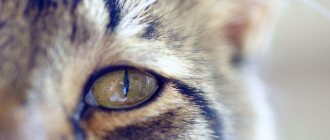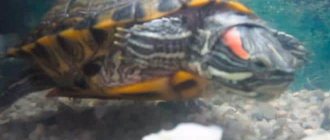It often happens that the eyes of domestic cats begin to water profusely. In some cases, the animal may feel significant discomfort, squint and even become lethargic.
The range of reasons that cause such a symptom can be wide - starting from the anatomical structure of the pet’s face, up to serious bacterial infections.
In any case, these discharges cannot be ignored - you should immediately contact a qualified specialist at a veterinary clinic .
Dirt in a cat's eye
Watery eyes can be caused by a clogged eye. Since a cat is a very clean creature, constantly licking its fur after eating, it is quite possible that a piece of hair or a speck of dust has gotten under the eyelid. In this case, only one eye will water. Watch your pet. If he is worried and rubs his muzzle with his paws, then perhaps a microscopic foreign body has actually gotten into his eye. Then you should wait a little while the debris is washed away with a tear.
If the cat remains restless for quite a long time, 3-4 hours, then you can help the pet by dropping an artificial tear into the eye. Drinking plenty of fluid will help flush out any remaining debris from the diseased organ.
Possible diseases that cause watery eyes
Determining why a kitten's eyes sometimes water is not easy at home. First you need to examine the animal, eliminating influence factors such as injuries and the presence of foreign bodies. If there are no obvious reasons, you should visit a veterinarian. Your pet may have:
- Allergy . The body reacts with watery eyes to all kinds of irritants (a new air freshener, food, toilet litter).
- Cold . When you have a cold, there is discharge of fluids from the eyes and nose. The cat becomes lethargic, refuses to eat or eats very little, and the body temperature is higher than normal.
- Parasites . Helminths release toxic substances. Once they enter the circulatory system, they reach the internal organs, affecting them. This provokes general intoxication of the cat’s body and lacrimation.
- Infection . The cause of tears is often infection of the body.
A common reason why a cat's eyes water is elementary vitamin deficiency. Due to the lack of nutrients, not only cats suffer, but it is in them that it manifests itself in the form of a wet spot on the cheeks.
Most often, a kitten's eyes are running due to vitamin deficiency. The problem can be solved by introducing vitamins and healthy supplements into the daily diet. If the kitten is suckling, then vitamins are given to the nursing cat.
Eye injury
Discharge from the eye can be caused by mechanical trauma. There are countless reasons. Mostly, pets often manage to scratch their eyes with their claws, but this can also happen after a fight with other cats.
A cat can also get an eye injury if it bumps into a foreign object, such as a thorny flowerpot. Take a closer look at the animal - when injured, the cat does not rub its face with its paws, as is the case with a clogged eyelid, but simply squints.
Please note that in case of any eye injury, you should immediately show the cat to an experienced veterinarian in order to avoid deterioration of vision or blindness of your beloved pet!
First aid and treatment
To completely cure an animal, you need to make a correct diagnosis. Treatment is usually carried out using drops and ointments, and immunity-supporting drugs are often included. Before determining the cause of lacrimation, you can clean the animal’s eyes yourself, using napkins or cotton pads. They should be moistened:
- chlorhexidine solution;
- infusions of herbs, such as chamomile or sage;
- boric acid solution (2%).
Such cleaning will not help cure the animal, but it will make the pet’s condition easier if its eyes stick together due to secretions, interfering with orientation in space.
A veterinarian will tell you how to properly care for your pet’s eyes in her video from Lina Vet’s Vet Tips channel.
Medicines
The doctor decides how to treat the animals after an examination: you should not do this yourself, because it can cause harm. So, little kittens can not do everything that is freely prescribed for adult animals. Eye drops such as:
- "Leopard";
- "Diamond Eyes";
- tsiprovet;
- anandin.
The last of the drugs stings noticeably, so the kittens scratch their eyes and get worried after the procedures. For bacterial conjunctivitis, it is recommended:
- chloramphenicol;
- kanamycin;
- sodium sulfate;
- sofradex (contains a hormone and is not recommended for corneal damage).
But, it is worth emphasizing that in case of allergies, none of the drugs listed will help - you will only torture the animal in vain. For proper treatment and advice, you should contact a veterinarian.
Traditional methods
If a cat’s eye is leaking, then treatment with folk methods, at best, can only help cleanse the organ of vision, preventing infection from developing. With already developing inflammation, this method of fight is unlikely to help. Experts recommend cleansing with decoctions of useful antiseptic plants: chamomile, St. John's wort, sage.
Allergies and parasites
The cause of lacrimation may lie in allergies. Yes, cats, like people, can be susceptible to allergic reactions to dust, food, flowering house plants, and even their own fur. If both eyes of a cat are watery, and he often sneezes and itches, then this may be a reaction to some allergen. In this case, a veterinarian must make a diagnosis to confirm the allergy.
By the way, allergies can be triggered by infection with helminths, the presence of which has a detrimental effect on the pet’s immunity. In Murmansk, you can contact the Favorit veterinary clinic for initial diagnosis, consultation with a veterinarian and purchase of anthelmintic drugs.
Why do cats have lacrimation?
In cats, lacrimation from the eyes can be either natural or pathological. In the first case, nothing threatens the health of the pet and only careful care of the cat is required. Pathological lacrimation is very unsafe for the animal, as it can lead to loss of vision. In this case, veterinarian intervention is required.
With pathological lacrimation, a watery discharge of a coffee-colored, cloudy or transparent color appears on the cat’s eyes. In addition, it should be noted that such lacrimation causes unpleasant feelings in the pet: itching, the cat constantly rubs its eyes with its paws, becomes lethargic, its body temperature may rise, loss of appetite, and the eye itself may close and swell.
With pathologies, a cat may cry due to...
- Mechanical damage and injury . This is also called keratitis, or inflammation of the cornea. Foreign objects can get into the eye area and cause discomfort in the pet and develop an inflammatory process. Keratitis is accompanied by a fear of light in pets, discharge of pus from the eyes, and redness of the eye area. The cat's eye closes and tears may flow from it.
- Burn . In the home, any aggressive household chemical can cause a corneal burn. Cats are often curious, so if a cat becomes interested in cooking, it can get burned and start squinting.
- Allergic reaction . Not only people, but also animals are susceptible to various manifestations of allergies. Pets can be allergic to different things: new food, household chemicals, fluff, tobacco smoke, etc.
- Colds . If a cat has a cold, its reaction is often manifested by constant lacrimation. In this case, you should immediately consult a doctor.
- Conjunctivitis . Chlamydia, various bacteria, viruses, and fungi cause a similar infection. The eye may become red and fester. For conjunctivitis, as for colds, you should consult a veterinarian.
- Incorrect eyelash growth . Eyelashes grow incorrectly, causing discomfort to the animal. In this case, you should also contact your veterinarian.
- Glaucoma . Your pet has increased intracranial pressure due to injury or illness. Glaucoma leads to enlargement of the eye and decreased visual acuity. Also, owners may often notice that with glaucoma, the animal’s eye is swollen. In the later stages of this disease, blindness is possible without any treatment.
- Epiphora, or profuse lacrimation . The owner may notice that the pet is constantly crying. Epiphora can lead to partial or complete blockage of the nasolacrimal duct. An advanced form of this pathology can cause dermatitis.
- Parasites . In pets, not only the intestines can suffer, but also the organs of vision, because worms are also found there. They cause inflammation, severe lacrimation and pus.
Of course, if you find that your cat’s eye is watery and won’t open and there is one of the above signs, you need to contact a veterinarian.
Watery eyes can also occur due to natural causes.
- After sleep . In this case, the cat can remove the tears itself by washing, or you just need to wipe the eye area with boiled water.
- Long wool . It may get into the eye and cause irritation. Owners should regularly trim the fur on their pet's face and brush it regularly.
- Sphynx breed . Lacrimation is a feature of the body. Doctors often diagnose this breed with “entropion,” which means the lower and upper eyelids may roll up. In this case, only surgery will help the pet.
- Age . Excessive tearfulness is characteristic of kittens whose eyes have recently opened. Often, as the cat grows up, such profuse tearing stops. The owner can wipe the pet's eyes several times a day with a cotton swab dipped in warm boiled water to prevent the kitten's eyes from sticking together.
Viral or bacterial eye infection
A cat's eyes may become watery due to a viral or bacterial infection. If your pet's discharge has been going on for quite some time, and it has become thick, cloudy white or yellow, then most likely there is an infection in the eyes that is rapidly gaining momentum.
This could be conjunctivitis, toxoplasmosis, or herpetic infection. It is necessary to undergo an examination by a veterinarian in Murmansk. Ignoring these alarming symptoms can significantly weaken your cat's vision and even lead to blindness. The specialist will prescribe a series of tests to identify a hidden infection in the body and draw up a treatment plan for your pet.
Symptoms of eye lacrimation
If a cat has watery eyes for a long time in one or both eyes, there is brown discharge or with a whitish tint, this is a manifestation of several serious diseases at once. Along with them, the animal also exhibits other signs of pathology:
- severe itching (the cat constantly rubs its eyes with its paws);
- lethargy and poor appetite;
- redness of the whites;
- increased body temperature;
- photophobia and swelling of the eyelids;
- dried crusts and hair loss in the corners of the eyes.
Pathological discharge may change its character. At first they are liquid and transparent, and after a day they are already thick and with pus, then they pass, then they appear with renewed vigor. If one of your cat's eyes is watery, swollen and squinting, you should not delay your visit to the veterinary clinic. Timely measures will completely relieve your pet from suffering and restore his vision.
Genetics and breed
The cause of increased lacrimation may also lie in genetics. There are breeds of cats in which constant lacrimation is caused by features of the anatomical structure, and is considered within normal limits. These are breeds of Scots, British, Persians, and exotics.
All cats, whose skull structure is characterized by a short, flat muzzle and large eyes, have narrowed tear ducts and small tear grooves, which is why fluid constantly flows from the edges of the eyelids, forming characteristic furrows.
Still, you shouldn’t blame the whole problem on genetics if your pet is one of the above breeds. It is better to once again consult with a veterinarian to determine the correct diagnosis.
Infectious diseases, worms
It is necessary to understand why tears flow from a cat’s eyes in order to exclude infection with helminths and infectious diseases, which not only can lead to the death of the animal, but also pose a danger to humans. Excessive lacrimation is observed with chlamydia, calcivirosis, rhinotracheid, which a person can become infected with from a sick animal.
Severely watery eyes and drooling are also observed when infected with rabies - an incurable disease transmitted from a sick animal to a person through a bite, saliva, or tear fluid getting into wounds, microcracks in the skin. To prevent infection with rabies, vaccinate your cat against rabies and other infectious diseases, and give anthelmintic drugs twice a year.
Attention! No self-medication!
The main rule for cat owners is not to self-medicate, no matter how simple the problem may seem. Remember that any wrong action or inaction you take towards your pet can negatively affect its health.
It is always better to contact a competent specialist, for example, to the Murmansk veterinary clinic “Favorite”, where you can always get a full range of consultations, diagnosis and treatment of all cat diseases.
"Favorit" - professional care for your pet!
When to contact a veterinarian
If you suspect a pathological cause of lacrimation (infection, trichiasis, foreign body, injury to the eye block), you should seek medical help. The veterinarian will prescribe the appropriate tests, determine the diagnosis and begin treatment.
You should seek emergency help if you have the following symptoms and conditions:
- disturbance of consciousness in a cat;
- injury to the eyeball, which is accompanied by its loss, bleeding or the presence of a penetrating wound;
- suspicion of a serious infectious disease (panleukopenia, calicivirosis).
In these cases, you should not delay treatment; you should contact a veterinarian immediately after identifying symptoms.
Prevention measures
It is impossible to completely eliminate the risk of viral and bacterial infections and colds for a domestic cat. But with the help of basic preventive measures, this danger can be significantly reduced.
The proposed rules are not onerous, but very effective:
- regular visits to the veterinarian;
- strict adherence to the vaccination schedule;
- timely implementation of antiparasitic measures;
- exclusion from the menu of products that cause unwanted reactions;
- regular wet cleaning, timely cleaning and washing of the cat bed;
- Protecting your cat from hypothermia and drafts.
After bathing, many owners dry their pet's coat with a hairdryer. In this case, it is necessary to ensure that the air is not too hot. You should not direct the air stream into the cat's face - this can cause drying of the nasal mucosa and snot.
Even the strictest adherence to preventive measures will not provide unambiguous protection against diseases, therefore, if signs of illness appear, it is necessary to observe the behavior and well-being of the cat and consult a veterinarian. You should not wait long, as this may prevent the start of effective treatment.
I like3I don't like
Treatment of tearing in cats
The nature of the treatment depends entirely on the cause of the pathology. If problems are detected with the anatomical structure of the nasopharynx, resulting in lacrimation and difficulty breathing, the doctor may even prescribe surgical intervention. In other situations, treatment is not difficult.
If an allergic reaction is detected, you need to get rid of the allergen and prescribe antihistamines.
If there are injuries or a foreign object is found in the eye, the wound should be treated and the object removed.
If an infection is detected, your doctor may prescribe antiviral medications or antibiotics. It is important to understand that there are diseases that require not only local treatment, but also general treatment.
Cataracts, increased intraocular pressure, and keratitis are most often treated with drops. The drug and dosage are selected individually, taking into account the general condition of the animal.
How to treat your pet at home
Having discovered that the cat's eye is watering, they find out the cause of the problem.
But you should not self-medicate. The only thing the owner can do before going to the vet is to rinse the pet's eyes.
First aid for watery eyes
The washing procedure is rational in cases where a foreign body, an irritating substance has gotten under the cat’s eyelid, or the animal has been injured.
It is best to use saline solution (0.2% Furacilin) in this situation, but it may not always be at hand.
Therefore, prepare boiled water and proceed to the following actions:
the liquid is cooled;- moisten a cotton pad in water and apply it to the pet’s eye;
- wipe, moving from the inner corner to the outer.
If there is a lot of discharge, pus or blood is present, the discs are changed several times during the treatment process. In this case, new material is taken for the next eye.
To make the procedure more convenient, it is recommended to involve an assistant who will hold the resisting cat.
Professional diagnostics
Only a specialist can determine how serious the pathology is. At the veterinary clinic, a comprehensive examination of the animal is performed, all necessary tests are taken, as well as eye washes.
The results obtained are correlated with the owner’s story about how the disease developed, what symptoms accompanied tearfulness, and whether the pet’s behavior changed. This helps the doctor fully assess the situation and choose the right treatment.
Medications
All medications are prescribed based on the cause of lacrimation:
for conjunctivitis, Kanamycin, Levomycetin or Sofradex are recommended: the prescribed drug is instilled into the affected eye up to 5 times a day;- if the doctor prescribes antibiotics in the form of an ointment (Tetracycline is most often prescribed), then it is applied 3 times a day;
- if the eyelid and dermis near the eye are swollen, and the cat experiences severe pain, then it is prescribed hydrocortisone or novocaine.
Ophthalmological diseases require specific treatment, which is selected individually in each specific case.
Before removing the foreign body, the cat is given an anesthetic injection. Then, taking a cotton swab, roll the eyelid outward and try to remove the foreign object from the eye with tweezers.
Folk recipes
You can wash the eyes of sick cats using the same folk remedies as used in treating people. For excessive tearing, herbal decoctions (St. John's wort, calendula, chamomile, sage) help well. You can also make lotions with single-use black tea bags.
Conjunctivitis and other eye diseases
Tears in a cat can be caused by eye diseases:
- conjunctivitis - the veterinarian prescribes laboratory tests to determine whether the disease is caused by a virus or bacteria, and prescribes treatment with antiviral or antibacterial drugs;
- cataracts – clouding of the lens occurs after injuries; in animals suffering from diabetes mellitus and other chronic diseases, identifying the disease in the early stages allows to slow down its progression;
- glaucoma - develops against the background of increased intracranial pressure; due to a violation of the outflow of intraocular fluid, the animal experiences severe discomfort; surgical and drug treatment will alleviate their condition and preserve vision.
How to prevent lacrimation?
Owners are advised to examine their pets' eyes daily. They should have the same shape, be clear, and have no discharge or other signs of inflammation.
If you have a small kitten, you need to provide him with the necessary hygiene. You can wipe your eyes with a bandage containing warm boiled water or any antibacterial solution. Furacilin is perfect. You can also use special drops. If an adult cat does not take good care of its own hygiene, then conjunctivitis is possible. In this case, you can use ointment or drops containing chloramphenicol. If the problem does not resolve itself within a few days, it is worth taking the animal to the veterinarian. Long-haired cats sometimes need the fur around their eyes trimmed. It is also very important to monitor the claws so that the pet does not accidentally injure its eyes when washing. Food and hygiene products must be properly selected.
If the owner follows all these rules and contacts the veterinarian for routine examinations, he will be able to avoid any eye problems in his cat. It is important to understand that prevention is simpler than any treatment. Following the tips described above will keep your pet's eyes healthy and clear-eyed for many years!
